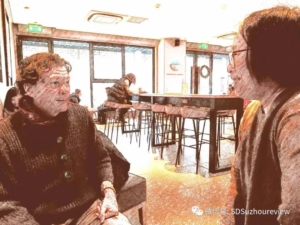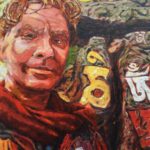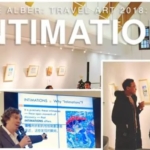2018, Suzhou Review
This interview was conducted by Sarita from Suzhou Review before the opening of the INTIMATIONS solo exhibition at KunChef in Kunshan, Jiangsu, China.
When did you start painting?
I started when I was a child. I went into my father’s study, he had some paints there, because he used to paint when he was younger. My brother and I were like, “oh my god, we’re painters today.” So I stuck with painting. I studied art in university, received an associate in art degree and then a bachelor in art degree, a BFA.
Does that mean you majored in watercolor painting?
I majored in print making. Like Chinese woodblock printing. I like woodblock and lithography the best.
 Where have you traveled in China?
Where have you traveled in China?
West China, Sichuan, Yunnan, Henan, Shanxi, Zhejiang, Beijing, Suzhou, Hong Kong, Macao, and Shanghai. In Shanghai, I enjoy the all the contemporary, modern buildings. I think they are amazing.
However Suzhou has one foot in old China and one foot in the new. There is a Buddhist temple in walking distance from here, which is very old. And from there you can take the subway to SIP or SND to see new China high-rises within an hour. It’s amazing.
How many paintings will be exhibited this time?
About 17 paintings.
Were these paintings all painted in China?
Most of them were painted in China, but some were painted in Myanmar and Nepal. The cover of the catalog was painted in Nepal. It is an oil painting.
How often do you paint?
It depends from week to week. But with a good painting week, I can paint maybe three or four days a week, at least six hours per day.
What stimulate you to pick up your brash? How do you pick what you will paint?
I want to paint the emotion of wonder. When you see something new, you are surprised. Something magic happens in your emotional experience. The open moment when you see something new, you have an experience that opens you.
When you go to a new place as a traveler, what strikes you the most?
It can be everything. In the INTIMATIONS solo show I have a painting of a street cleaner. For me, the image struck me with cross-cultural associations. For someone living in China, it’s probably something you see everyday. But for a traveler, it’s new. It’s surprising. I saw this street cleaner in Suzhou. On his three wheeled cart, the whole image reminded me of a Garuda, which is a magical bird from pan-Indian myth. For me, the broom in the back of the cart, looked like the bird’s feathers, the little cart like its body. So the street cleaner seemed like the rider of this magical bird, like a god.
I think the continuity of culture is very important. It informs us — with a type of pleasure and joy — that we are part of something that is larger than going to work everyday. We are part of this enormous human cultural continuity. We really share it. As a traveler you get to share this experience with other people of different cultures.
What is the theme of the exhibition?
Intimations means ‘suggestions’, ‘hints’. Like what we’ve been talking about, looking at a painting of the Chinese street sweeper or a temple, and feeling through the image the hints and suggestions of the experience of wonder.
With every painting, my intention is to express the open experience of wonder at having a new experience… experiencing something new as a traveler. So seeing that street sweeper riding on the three-wheel cart, I said, ‘wow, it looks like a garuda.’ I was struck by that experience of two cultures mixing in one image.
When traveling, I am also often struck by reflections in water. In the INTIMATIONS exhibit there’s a painting of a Buddhist temple on Chinese New Year’s Eve. I painted a special place at a special moment. There was the scent of incense burning; the sound of chanting; the ceremony going on inside. And as we walked toward this temple, there was a beautiful reflection mirroring this whole experience. I just wanted to capture that moment.
So the exhibition is still a bit private, about yourself, about recording what you feel?
Definitely. But I really hope to communicate about that open experience of wonder. When people are refreshed by any new experience, the open experience of wonder is transmitted to them. If even the suggestion of that experience is communicated to the guests at the art gallery, then I’d feel very happy with people’s responses to it.
Who you expected to be the audience at your exhibition?
Local people. Kunshan local people.
What about the books you wrote?
Recently, I’ve been combining both travel writing and travel painting. I’ve also written a book on world mythology. Studying culture, I look at culture. Not just at the surface level, but at a deep cultural level. I ask, “What are the stories that people are shaped by? What are the stories that we live with?”
In China, for example, the “Journey to the West”, and San Guo (the “Romance of the Three Kingdoms”), are stories that inform people’s lives. There is a friend of mine. She’s a young Chinese businesswoman who operates an English school. San Guo is part of who she is. The stories in San Guo are all about smart people strategizing their way through difficult situations. How to outsmart their opponent. That reflects who she is as business woman. Not that she’s competing with people, but for her to operate her business, she has to be a smart person.
Touching on our shared cultural heritage is important to me. For example, I wrote an article about Chinese temples for Suzhou Review. A Suzhou-ren or traveller may see the temple, but not really understand it. Is it a Buddhist temple or a Confucian temple or a Taoist temple? To help people answer these questions, I wrote the article so that people could distinguish them and say, “That’s a Confucian temple; I know what that is.” There is a history and culture associate with the building, and that as cultured human beings, we can all share in that experience.
Will mythology help you understand local people of a new place you travel?
Yes. I reflect on it everywhere. I read local people’s history, mythology, and religious literature. Two years ago, I went to Sri Lanka. I read a book about Buddhist myths and legends in Sri Lanka. So when I was there, it was what I read before going sleep. It gave me a stronger impression about the whole island and the whole cultural experience.
The feeling of identity that we carry with us comes from this long continuity of culture, history, and mythology.
Is there any legendary story that helped you to understand Suzhou people?
Regarding Suzhou people, I’m more struck by history than mythology. I think people are certainly very soft spoken and polite. Suzhou people care for aesthetics more than most anywhere else in China. I think in China, Suzhou-ren have the care for the Chinese ink paintings, for the Chinese gardens, and for cha dao (“tea ceremony”). There is a sense of cultural continuity that relates to Chinese arts, and Chinese aesthetics that is alive in Suzhou. I think that comes from the Ming and Qing democratization of arts. So the arts were not only for the aristocrats, but as a general, as military people began to get more money in the Ming Dynasty, they set up little homes in Suzhou, set up gardens, and started to learn painting, and all studied music. I think that were very alive in Suzhou. It is one of the things that make Suzhou very unique. I see it also very much in Hangzhou—in Hangzhou and Suzhou are both very strong—but I think that in Suzhou is stronger now. I heard some people from manufacturing say that they find competing with Hangzhou people very difficult, because Hangzhouren want the cheapest quality with cheapest materials, but they can make good money from it. But Suzhouren feel reservation about making something cheap. They want to make something quality. So some of that sense of aesthetic sensibility has been kept alive from the continuity of Suzhou history.
Do you often embed local mythology into your painting about a certain place?
Not always but it’s there. For example, the ‘nian’, the New Year, story. The New Year is coming up. In China there is the story about the ‘nian’. Nian is a legendary monster that eats people. But what is the ‘nian’. This is how mythology works. It’s metaphorical type of language. Nian is time. What eats people. Time eats people. Every year the ‘year’ eats someone. The nian monster has some feast. We are all sadder because that feast. So every year we can say we escaped the year.
Have you ever cooperated with local artists?
The language can sometimes be the barrier, but I hope to do more this year. I want to send the catalog to galleries. I think I should send information out to the community, and, specifically, talk about how we can collaborate in the future. I have some ideas for some shows I want to do. But it is too early to say. I have a nice show that I want to do, that specifically to some of Suzhou’s tourist attractions: gardens, some streets and related to technology. So it will be a mix of oil painting, new technology and Suzhou’s sites. I think it should be exciting. But that’s the future.
So do you mean you will have more exhibitions in Suzhou?
Yes, definitely.


